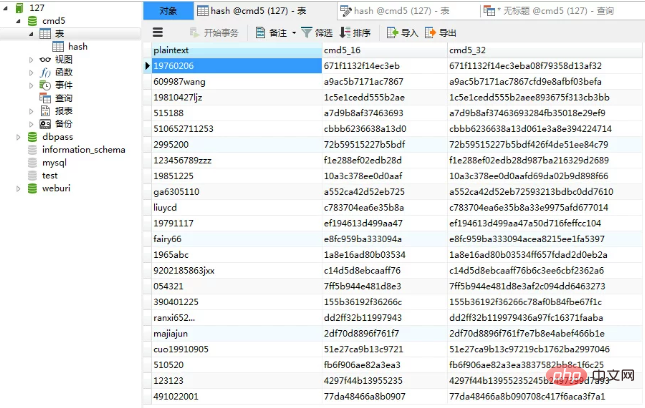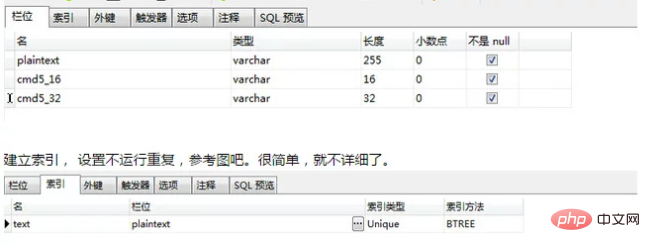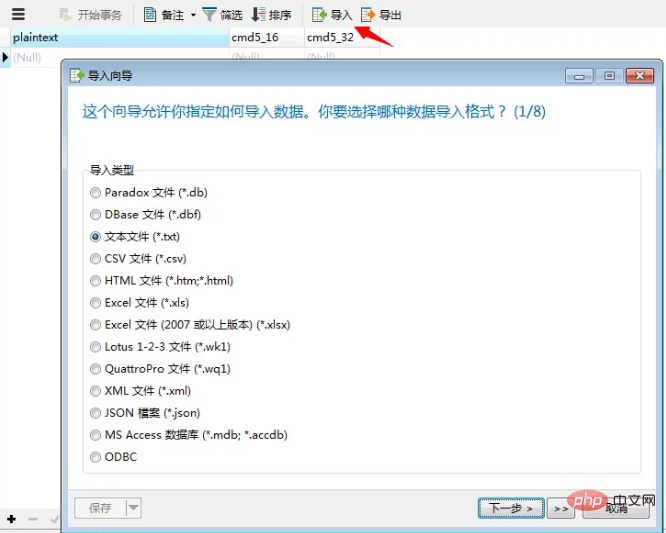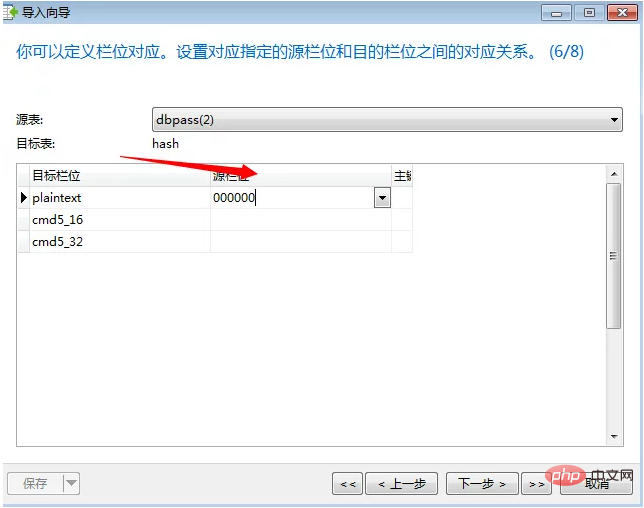 Database
Database
 Mysql Tutorial
Mysql Tutorial
 About building billion-level cmd5 database with mysql and millisecond-level query (complete process)
About building billion-level cmd5 database with mysql and millisecond-level query (complete process)
About building billion-level cmd5 database with mysql and millisecond-level query (complete process)
Foreword:
I have also been playing with databases recently, and I feel that ordinary machines are still a little behind when it comes to databases. Full-text search can take more than a minute if it is slow.
But the cmd5 library is very good, a billion-level database, millisecond level.
Okay, let’s start. First, you need a mysql database.
Environment:
apmserv5.2.6 php+mysql Navicat for MySQL
Recommended these two software, the installation is very simple, both are in Chinese, so it is easy for novices to operate.
Other things needed are a computer and about 10GB of hard drive space. A larger dictionary.

# Let’s start the first part, open the Navicat for MySQL connection, it’s very simple, I won’t take a screenshot here.
Recommendation: "mysql video tutorial"
Start creating the table, hash_cmd5, field, plaintext, cmd5_16, cmd5_32
are all set to not empty , the first is 255, the second is 16, and the third is 32 bits.

#Start importing data. It’s very simple. Just refer to the picture and figure it out yourself.

#Refer to your own database source and set the encoding

Refer to your own database content.

The fourth and fifth parts can be skipped directly.
Start the sixth step, you only need to set plaintext, other fields do not need to be set, but the prerequisite must be to select the plaintext found in the database, otherwise it will be meaningless.

#Go directly to step 8 to import data.
Let’s try it yourself. The next step is to teach you how to batch generate cmd16 32-bit.
High-speed single table import
If: your text file is in d:\aa.txt
Table name: t
Field name: c
is the following command
mysql> load data local infile 'd:/aa.txt' into table cmd5 lines terminated by ',' (cmd5_txt);
Create 32 16-bit md5 with one click
update `hash` set cmd5_16 = substr(md5(plaintext), 1, 16) where 1=1 update `hash` set cmd5_32 = md5(plaintext) where 1=1
As for some experts, this The method is unstable and so on. When tested on a single machine, there is no pressure on a single table of 600 million.
The above is the detailed content of About building billion-level cmd5 database with mysql and millisecond-level query (complete process). For more information, please follow other related articles on the PHP Chinese website!

Hot AI Tools

Undresser.AI Undress
AI-powered app for creating realistic nude photos

AI Clothes Remover
Online AI tool for removing clothes from photos.

Undress AI Tool
Undress images for free

Clothoff.io
AI clothes remover

AI Hentai Generator
Generate AI Hentai for free.

Hot Article

Hot Tools

Notepad++7.3.1
Easy-to-use and free code editor

SublimeText3 Chinese version
Chinese version, very easy to use

Zend Studio 13.0.1
Powerful PHP integrated development environment

Dreamweaver CS6
Visual web development tools

SublimeText3 Mac version
God-level code editing software (SublimeText3)

Hot Topics
 PHP's big data structure processing skills
May 08, 2024 am 10:24 AM
PHP's big data structure processing skills
May 08, 2024 am 10:24 AM
Big data structure processing skills: Chunking: Break down the data set and process it in chunks to reduce memory consumption. Generator: Generate data items one by one without loading the entire data set, suitable for unlimited data sets. Streaming: Read files or query results line by line, suitable for large files or remote data. External storage: For very large data sets, store the data in a database or NoSQL.
 How to use MySQL backup and restore in PHP?
Jun 03, 2024 pm 12:19 PM
How to use MySQL backup and restore in PHP?
Jun 03, 2024 pm 12:19 PM
Backing up and restoring a MySQL database in PHP can be achieved by following these steps: Back up the database: Use the mysqldump command to dump the database into a SQL file. Restore database: Use the mysql command to restore the database from SQL files.
 How to optimize MySQL query performance in PHP?
Jun 03, 2024 pm 08:11 PM
How to optimize MySQL query performance in PHP?
Jun 03, 2024 pm 08:11 PM
MySQL query performance can be optimized by building indexes that reduce lookup time from linear complexity to logarithmic complexity. Use PreparedStatements to prevent SQL injection and improve query performance. Limit query results and reduce the amount of data processed by the server. Optimize join queries, including using appropriate join types, creating indexes, and considering using subqueries. Analyze queries to identify bottlenecks; use caching to reduce database load; optimize PHP code to minimize overhead.
 How to insert data into a MySQL table using PHP?
Jun 02, 2024 pm 02:26 PM
How to insert data into a MySQL table using PHP?
Jun 02, 2024 pm 02:26 PM
How to insert data into MySQL table? Connect to the database: Use mysqli to establish a connection to the database. Prepare the SQL query: Write an INSERT statement to specify the columns and values to be inserted. Execute query: Use the query() method to execute the insertion query. If successful, a confirmation message will be output.
 How to create a MySQL table using PHP?
Jun 04, 2024 pm 01:57 PM
How to create a MySQL table using PHP?
Jun 04, 2024 pm 01:57 PM
Creating a MySQL table using PHP requires the following steps: Connect to the database. Create the database if it does not exist. Select a database. Create table. Execute the query. Close the connection.
 How to use MySQL stored procedures in PHP?
Jun 02, 2024 pm 02:13 PM
How to use MySQL stored procedures in PHP?
Jun 02, 2024 pm 02:13 PM
To use MySQL stored procedures in PHP: Use PDO or the MySQLi extension to connect to a MySQL database. Prepare the statement to call the stored procedure. Execute the stored procedure. Process the result set (if the stored procedure returns results). Close the database connection.
 How to fix mysql_native_password not loaded errors on MySQL 8.4
Dec 09, 2024 am 11:42 AM
How to fix mysql_native_password not loaded errors on MySQL 8.4
Dec 09, 2024 am 11:42 AM
One of the major changes introduced in MySQL 8.4 (the latest LTS release as of 2024) is that the "MySQL Native Password" plugin is no longer enabled by default. Further, MySQL 9.0 removes this plugin completely. This change affects PHP and other app
 The difference between oracle database and mysql
May 10, 2024 am 01:54 AM
The difference between oracle database and mysql
May 10, 2024 am 01:54 AM
Oracle database and MySQL are both databases based on the relational model, but Oracle is superior in terms of compatibility, scalability, data types and security; while MySQL focuses on speed and flexibility and is more suitable for small to medium-sized data sets. . ① Oracle provides a wide range of data types, ② provides advanced security features, ③ is suitable for enterprise-level applications; ① MySQL supports NoSQL data types, ② has fewer security measures, and ③ is suitable for small to medium-sized applications.





